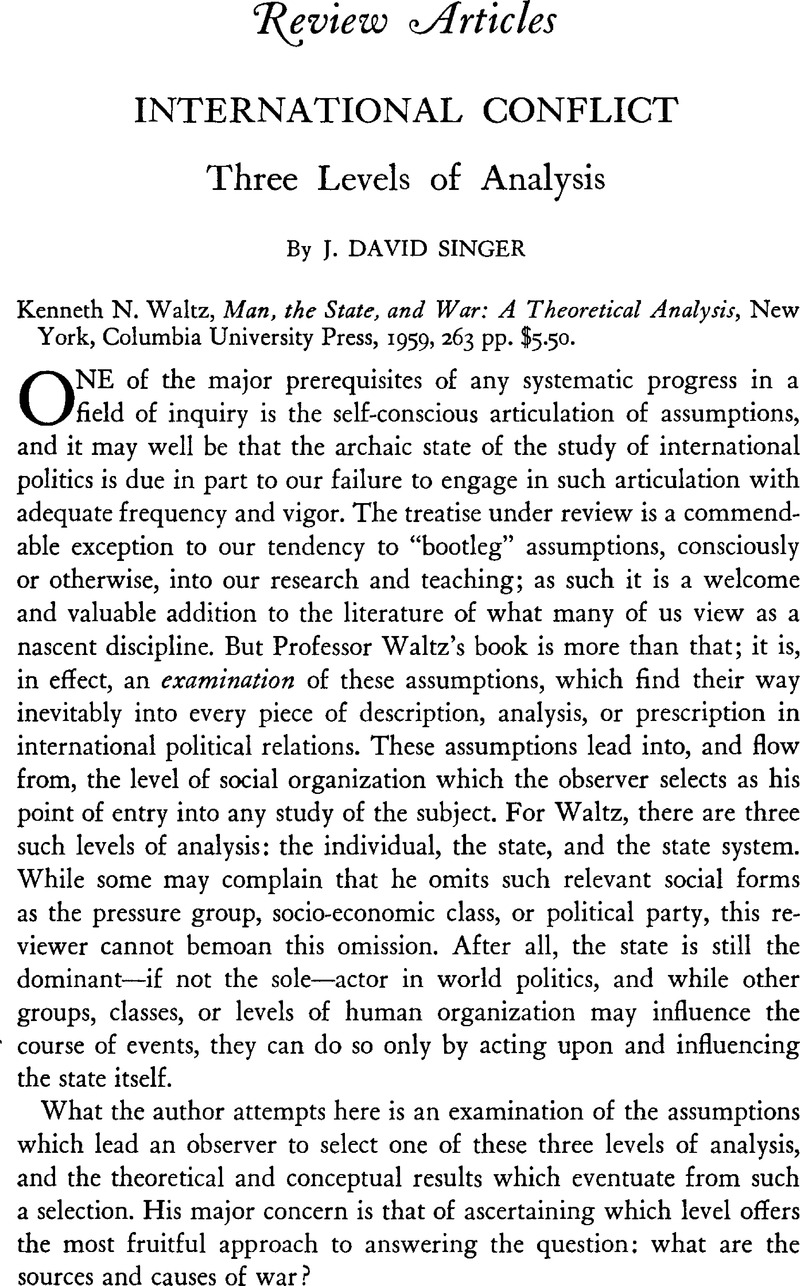Article contents
International Conflict Three Levels of Analysis
Review products
Published online by Cambridge University Press: 18 July 2011
Abstract

- Type
- Review Articles
- Information
- Copyright
- Copyright © Trustees of Princeton University 1960
References
1 One may question the validity of associating Morgenthau with this group. Though he does postulate that the world “is the result of forces inherent in human nature” (p. 4), his entire theoretical structure focuses on the behavior of states (conceived as organic entities) within the state system. This reviewer would categorize Morgenthau as a “third-image analyst.” See Politics Among Nations, New York, 1956.
2 The behavioral sciences are meant here to include only anthropology, sociology, psychiatry, and psychology. Some would add the other social sciences: economics, his tory, political science, and perhaps geography; see The Behavioral Sciences at Harvard, Cambridge, Mass., 1954. And others might even include biology and physiology, as, for example, Miller, James C., “Toward a General Theory for the Behavioral Sciences,” American Psychologist, X, No. 9 (September 1955), pp. 513–31.CrossRefGoogle Scholar
3 Those familiar with mese names will appreciate the difficulty of categorizing them by discipline, as well as the grossness of any category encompassing figures as disparate as Miller and Klineberg, for example.
4 Not to mention the policy implications of a fuller Western comprehension of the cultural values, aspirations, and prejudices of the peoples of China, India, Poland, or Egypt.
5 For example, how many of us are aware of the rather persuasive evidence that in-group loyalty need not rely upon antagonism toward an out-group? See Guetzkow, Harold, Multiple Loyalties, Princeton, N.J., Center for Research on World Political Institutions, 1955.Google Scholar
6 These last two items are particularly applicable to the author under review and to the traditional philosophers, from whom he seems to have received much intellectual sustenance.
7 Among the sources of such analogies are the following compendia: Lindzey, Gardner, ed., Handbook of Social Psychology, Cambridge, Mass., 1954, 2 vols.Google Scholar; Kluckhohn, Clyde and Murray, Henry, eds., Personality in Nature, Society and Culture, New York, 1948Google Scholar; Grinker, Roy, Toward a Unified Theory of Human Behavior, New York, 1956Google Scholar; Swanson, G. E., Newcomb, T. M., and Hartley, E. L., Readings in Social Psychology, New York, 1952Google Scholar, rev. ed.
8 For a sampling of these possibilities, see such interdisciplinary and “general system” journals as Behavioral Science, General Systems and, in a less explicit fashion, the Journal of Conflict Resolution.
9 From the reviewer's own experiences in interdisciplinary seminars, conferences, and research projects, and as an editor of the Journal of Conflict Resolution, there seems to be considerable humility and willingness to learn on the part of behavioral scientists concerned with international politics.
10 Quoting McDonald, John, Strategy in Poker, Business and War, New York, 1950.Google Scholar Waltz makes passing reference to other works on game theory, and occasionally utilizes its concepts with success, but generally fails to appreciate some of its more subtle and promising aspects in the study of international politics. For a stimulating discussion of such potentialities, see Schelling, Thomas C., “The Strategy of Conflict: Prospectus for a Reorientation of Game Theory,” Journal of Conflict Resolution, 11, No. 3 (September 1958), pp. 203–64.CrossRefGoogle Scholar
11 Frank Tannenbaum is the hapless victim here; see especially his “Balance of Power versus the Co-ordinate State,” Political Science Quarterly, LXVII, No. 2 (June 1952), pp. 173–97.
12 Politics Among Nations, pp. 477 and 485.
13 Other social scientists, too, are constantly confronted by this paradox. See, for example, Otis Duncan and Leo Schnore, “Cultural, Behavioral, and Ecological Perspectives in the Study of Social Organization,” and Rossi's, Peter “Comment,” both in American Journal of Sociology, LXV, No. 2 (September 1959), pp. 132–53.Google Scholar
14 Two rather fruitful attempts at dealing with this dilemma are Angell, Robert C., “Governments and Peoples as Foci for Peace-oriented Research,” Journal of Social Issues, XI, No. 1 (1955), pp. 36–41CrossRefGoogle Scholar, and Dunn, Frederick S., War and the Minds of Men, New York, 1950Google Scholar, ch. 2, “The Changing Focus on International Events.”
- 31
- Cited by


